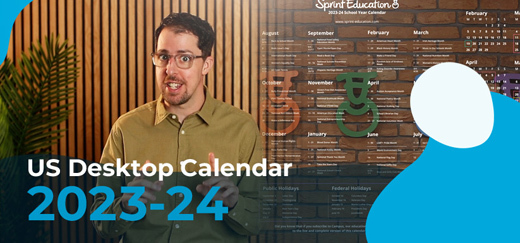CPD isn't a priority for teachers: why it matters to your marketing
CPD isn't a priority for teachers: why it matters to your marketing
Only 10.2% of teachers say training is a key priority for them in 2020.
Only 10.2% of teachers say training is a key priority for them in 2020.
In week three of our examination of Promethean’s annual report “The State of Technology in Education,” we seek to uncover why the number of educators making teacher training a priority has more than halved since last year.
Is staff training a priority for schools?
Perhaps an even more divisive topic than workload is the topic of teacher training.
This prickly pear bears little fruit for those looking to reconcile the opinions of SMTs and teachers on school priorities.
Significantly more teachers (22.7%) said that they “don’t know” what their school’s priorities are, as opposed to SMT members (5.4%). Indicating that members of senior leadership do know what their priorities are and where training fits into them, but they’re not being communicated effectively.
There is also a huge difference in perceived funding priorities, with 61.3% of senior management teams identifying training as a priority compared with 29.7% of teachers. The disparity likely originates from not only a breakdown in communication but separate and distinct priorities specific to individual responsibilities.
A communication barrier is further evident in the disparity between the number of teachers that didn’t know whether training was a funding priority compared to SMT members. Over 40% of teachers didn’t know whether training was a funding priority, whereas only 6% of SMT members were unsure.
It seems that knowledge of schools’ strategic priorities is failing to permeate below the level of senior leadership in many schools.
Senior leadors show a keen interest in supporting CPD in pursuit of better outcomes, but teaching staff with heavy workloads are finding it difficult to make time for training. Aspects of which are the difficulty and expense of not only attending the training but organising cover for lessons. (2)
For schools coping with tight operating budgets and poor teacher retention, the prospect of prioritising teacher training comes with several logistical challenges besides making time for the training itself.
Reinforcing that this is one of the points of greatest contention between SMTs and Teachers is that nearly 50% of SMTs think funding is currently at the right level compared with only 20.3% of teachers and 21.3% of IT managers.
Trends and opportunities identified:
- Budgets are tight, and schools are cautious investors – training providers can use case studies to prove the efficacy of their programs on student outcomes and overcome objections.
- Teachers have limited time, and arranging cover is difficult and expensive – training should strike a balance between being flexible and effectively delivered.
- Senior Management Teams identify delivering new learning strategies, creative learning experiences, and better results are their top three priorities for the coming year – communicate the benefits of your service or product to these areas of teaching practice to SMTs.
- Because school management consists of teachers, there is little awareness about what training IT staff and teachers require on new technology – include IT teams in relevant communications regarding educational technology products and services, or tailor additional comms directly to IT teams.
Are teachers getting the training they need on education technology?
The stats suggest they are not.
In 2016/17, more than half of teachers (55%) reported receiving sufficient training and support on technology in schools. That number has since dropped to just 16.5%.
The drop in tech training may be symptomatic of teachers receiving technology training in a non-linear fashion. The problem with this being that changes in technology outpace changes in other areas of the teaching practice.
Because advances in technology occur rapidly, tech training has a short shelf life, whereas training on areas of the teaching practice based on static principles remains relevant for many years. For instance, leadership training and teaching strategies; the qualities of good leadership are the same today as they were when Cleopatra ruled Egypt, and the Socratic method is still in use as a teaching strategy over 2400 years after its namesake’s death. Those are extravagant examples, but the point remains intact.
Trends and opportunities identified:
- Less than 20% of teachers are receiving adequate training and support on technology – there is a demand for tech training and support; however, it may not be a priority.
- Training on technology does not occur in regular intervals – effective education technology training that adheres to a regimen would be successful at creating linear improvements in teachers’ skills and repeat business.
Why isn’t training being delivered?
It is not surprising that budget and time restrictions are the primary reasons for training falling down the list of schools’ priorities.
The DfE’s survey of nearly 1,800 teachers and school leaders from 2018 reports that 9 out of 10 teachers experience difficulty accessing CPD, cost being a major factor, and over half of those cite time constraints as a barrier. (2)
Despite more than 60% of senior management members identifying training as a funding priority, 58% of respondents cited the reason for more training not being provided as a lack of budget.
There is very little harmony when it comes to the viewpoints of SMTs, Teachers, and IT teams on teacher training. While the desire for training exists, and all groups are aware of its importance, budgets appear to be obstructing its delivery.
It has also sunk on teachers’ priorities specifically due to the significant time restrictions levied on them by unmanageable workloads. Confirmed by the quarter of respondents (25.2%) that don’t believe more training is provided at their schools because there isn’t time to deliver it.
Trends and opportunities identified:
- Time and budget for subsequent training are limited – EdTech providers should make the development and delivery of training to accompany products and services a priority, ensuring effective use and wider adoption from the outset.
- Budgets are the area of greatest concern, and schools are cautious investors – reach schools by creating free assets that add value by solving specific problems and winning trust.
The one thing businesses should understand about staff training in schools for 2020:
It isn’t a top priority for most schools.
Budgets are inadequate, and time is scarce.
How do you overcome this?
Focus your marketing on what is a priority. For schools, this is always whatever will have the most impact.
It’s not enough to state that your product, service, or training improves learning and outcomes - you have to prove it. If you can demonstrate a tangible impact on outcomes, you’ll have schools’ attention.
When schools begin seeing results, so will your marketing.
References:
- The State of Technology in Education. (2019). [online] Promethean World. Available at: https://resourced.prometheanworld.com/technology-education-industry-report/#schools-strategic-goals [Accessed 14 Nov. 2019].
- The School Snapshot Survey: Summer 2018. (2018). [ebook] Department for Education, p.52. Available at: https://assets.publishing.service.gov.uk/government/uploads/system/uploads/attachment_data/file/773842/Summer_2018_SSS_Final_Report.pdf [Accessed 15 Nov. 2019].
- Stannard, R. and Matharu, S. (2019). Using technology to provide greater flexibility and access to continuing professional development. Innovations in the continuing professional development of English language teachers. [online] British Council, p.161. Available at: http://englishagenda.britishcouncil.org/sites/default/files/attachments/pub_e168_innovations_in_cpd_final_v2_web.pdf [Accessed 15 Nov. 2019].
Tags
Emailing Teachers
Marketing to Schools
Similar Articles


The 'EdTech Wishlist' of 1,039 Teachers (New Survey)
The EdTech and software insights you need to really tick teachers’ boxes.


Gathering education insights (8 quick tips)
Learn 8 quick tips to improving your education marketing strategies with direct school insights, and the benefits of online studies and surveys.


Expert marketing to K-12 support and solutions
Expert marketing to K-12 solutions
Email Principals, Teachers, and District Staff Inboxes
Email teachers and staff inboxes
Sell More to US and Global Schools and Districts
Sell more to schools and districts
































